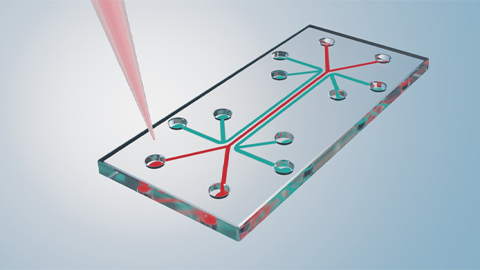
Detecting infection complications with nanoscale bacterial buds
Sepsis is an inflammatory overreaction to an infection, viral or bacterial, within the body and is the leading cause of death in hospitals. The reaction causes changes such as an intense fever or lowered blood pressure, which may damage vital organ systems if not promptly treated. Early detection may help save lives, but diagnosing patients with sepsis remains a clinical challenge.
Outer membrane vesicles, or OMVs, are nanoscale buds released from the outer membranes of Gram-negative bacteria in response to stress or other environmental changes. Bacteria use these OMVs to remove unwanted molecules and share helpful biomolecules with each other. OMVs can also trigger an inflammatory response during infection. Detecting these buds may be a quicker and more efficient way to identify Gram-negative bacterial sepsis than current diagnostic methods.

Nico Burgado, an undergraduate student in Lea Michel’s lab at the Rochester Institute of Technology, has been studying OMVs. “Usually, when doctors are trying to diagnose sepsis, the patients are already on antibiotics so when they take blood samples, no bacteria show up,” Burgado said. “We need a way to diagnose sepsis after they give the antibiotics, and a good way to do that is OMV detection.”
Burgado, Michel and their team explored OMVs in relation to E. coli sepsis. “We can detect biomolecules that are specific to the parent bacteria,” Burgado said. “After we isolate the OMVs, these biomarkers can help us determine which bacteria are causing the sepsis.”
In a recent study, the researchers used blood plasma samples collected from hospital patients by clinicians. The Michel team isolated the OMVs from these samples, using centrifugation, syringe filtering and ultracentrifugation. They then used Western blot analysis to detect the presence of E. coli proteins.
“The antigens are specific for E. coli, so if we detect any bands, that should mean that there’s E. coli OMVs in the plasma sample,” Burgado said.
The study showed that OMV detection is a promising method to diagnose Gram-negative sepsis. “The real clinical significance is that it’s a path to diagnosing sepsis, identifying the bacterial cause early on, and treating patients with the right antibiotics before they either have more complications or pass away,” Burgado said.
So far, the team has shown that, for the most part, they can isolate E. coli OMVs from the plasma of sepsis patients and detect E. coli biomarkers in the samples. In future studies, the researchers plan to test the sensitivity and accuracy of their diagnostic method and establish a baseline for detecting OMVs from E. coli and other common sources of bacterial sepsis.

Details
Nico Burgado will present this research from 4:30 to 5:30 p.m. CDT on Monday, March 25, at Discover BMB 2024, the American Society for Biochemistry and Molecular Biology annual meeting in San Antonio. His poster is at Board 273.
Abstract title: Using outer membrane vesicles to diagnosis sepsis in clinical samples
Enjoy reading ASBMB Today?
Become a member to receive the print edition four times a year and the digital edition weekly.
Learn moreGet the latest from ASBMB Today
Enter your email address, and we’ll send you a weekly email with recent articles, interviews and more.
Latest in Science
Science highlights or most popular articles

Adults grow new brain cells
How does the rare birth of these new neurons contribute to cognitive function?

From the journals: JBC
Histone demethylase inhibited by own sequence. MicroRNA reduces cell cycle–related apoptosis. Multipurpose antibiotic takes on staph infections. Read about recent JBC papers on these topics.

Tiny laboratories that fit in your hand can rapidly identify pathogens using electricity
Pathogens have distinct electrical charges, shapes and sizes. Measuring how quickly they move through an electric field can help researchers separate different species in a sample.

Toxoplasma gondii parasite uses unconventional method to make proteins for evasion of drug treatment
This recent study by a team from Bill Sullivan’s lab at the Indiana University School of Medicine was named a Journal of Biological Chemistry Editor’s Pick.

Of genes, chromosomes and oratorios
Jenny Graves has spent her life mapping genes and comparing genomes. Now she’s created a musical opus about evolution of life on this planet — bringing the same drive and experimentalism she brought to the study of marsupial chromosomes.

Ubiquitination by TRIM13: An ingredient contributing to diet-induced atherosclerosis
Researchers help unravel the molecular mechanism behind plaque formation in cardiovascular disease.

